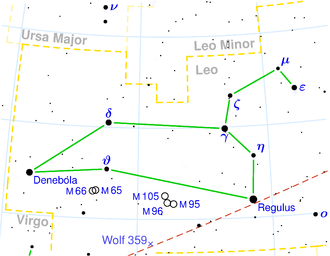NGC 3767
| Galaxy NGC 3767 |
|
|---|---|
![NGC 3767 & LEDA 213864, [1] SDSS image](https://upload.wikimedia.org/wikipedia/commons/thumb/f/f6/NGC3767_-_SDSS_DR14.jpg/300px-NGC3767_-_SDSS_DR14.jpg)
|
|
| NGC 3767 & LEDA 213864 , SDSS Recording | |
| AladinLite | |
| Constellation | lion |
|
Position equinox : J2000.0 , epoch : J2000.0 |
|
| Right ascension | 11 h 37 m 15.5 s |
| declination | + 16 ° 52 ′ 38 ″ |
| Appearance | |
| Morphological type | (R) SB (r) 0 ^ 0 ^? |
| Brightness (visual) | 13.8 mag |
| Brightness (B-band) | 14.8 mag |
| Angular expansion | 1 ′ × 0.9 ′ |
| Position angle | 75 ° |
| Surface brightness | 13.5 mag / arcmin² |
| Physical data | |
| Redshift | 0.021221 +/- 0.000103 |
| Radial velocity | 6362 +/- 31 km / s |
|
Stroke distance v rad / H 0 |
(281 ± 20) x 10 6 ly (86.3 ± 6.1) Mpc |
| history | |
| discovery | John Herschel |
| Discovery date | March 17, 1831 |
| Catalog names | |
| NGC 3767 • UGC 6590 • PGC 35969 • CGCG 097-031 • MCG + 03-30-023 • IRAS 11346 + 1708 • 2MASX J11371552 + 1652381 • LEDA 35969 • LDCE 829 NED001 | |
NGC 3767 is a lenticular galaxy of the Hubble type SB0 in the constellation Leo, north of the ecliptic . It is estimated to be 281 million light years away from the Milky Way and has a diameter of around 85,000 ly.
In the same area of the sky is the galaxy NGC 3768 .
The object was discovered by John Herschel on March 17, 1831 .
